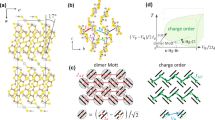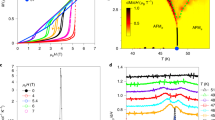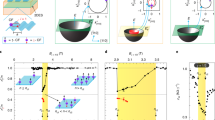Abstract
Coupling between the spins (magnetic moments) of assemblies of ions can lead to ordered magnetic systems—classified as ferromagnetic, antiferromagnetic, ferrimagnetic and so forth, depending on the nature of the ordering1. A simple picture of the coupling and ordering is usually adequate for describing properties of these systems, such as the magnitude and thermal variation of the magnetization. Here we describe a system whose magnetic behaviour appears counterintuitive on the basis of this picture. The materials in question are based on the ferromagnetic compound, SmAl2, in which some of the magnetic samarium ions, Sm3+, have been substituted with other rare-earth elements. The resulting system exhibits the seemingly incompatible properties of large spin polarization but no bulk magnetization: this state occurs at a specific temperature, when the two components of the magnetization (the electron's spin and its orbital motion) exactly compensate for one another. This property should be generic to ferromagnets containing trivalent samarium ions, and may find potential application in, for example, spin-resolving devices for charged particles.
This is a preview of subscription content, access via your institution
Access options
Subscribe to this journal
Receive 51 print issues and online access
$199.00 per year
only $3.90 per issue
Buy this article
- Purchase on Springer Link
- Instant access to full article PDF
Prices may be subject to local taxes which are calculated during checkout



Similar content being viewed by others
References
Chikazumi,S. Physics of Ferromagnetism. (Oxford Univ. Press, 1997).
Van Vleck,J. H. The Theory of Electric and Magnetic Susceptibilities, Sec. 59 (Oxford University Press, 1932).
Adachi,H., Ino,H. & Miwa,H. Effect of conduction–electron polarization on the magnetism of hcp samarium metal. Phys. Rev. B 56, 349–354 (1997).
Adachi,H., Ino,H. & Miwa,H. Separation of the 4f-spin, 4f-orbital and conduction–electron magnetization from exotic thermomagnetic behavior of ferromagnetic Sm intermetallics. Phys. Rev. B 59, 11445–11449 (1999).
Legvold,S. et al. Magnetic properties of gadolinium-rich alloys. Phys. Rev. B 16, 4986–4989 (1977).
Stewart,A. M. The ordered moment of metallic samarium materials. Phys. Status Solidi B 52, K1–K4 (1972).
Koehler,W. C. & Moon,R. M. Magnetic structures of samarium. Phys. Rev. Lett. 29, 1468–1472 (1972).
Givord,D., Morin,P. & Schmitt,D. Unusual form factor in SmZn. Phys. Lett. A 73, 221–223 (1979).
Adachi,H. et al. Evidence for positive polarity of the spin moment in hcp Sm determined from a magnetic Compton-scattering experiment. Phys. Rev. B 56, R5744–R5746 (1997).
Williams,H. J., Wernick,J. H., Nesbitt,E. A. & Sherwood,R. C. Magnetic properties of rare earth aluminum compounds with MgCu2 structure. J. Phys. Soc. Jpn 17 (suppl. B-I), 91–95 (1962).
Grover,A. K., Malik,S. K., Vijayaraghavan,R. & Shimizu,K. Hyperfine fields in Sm1-xGdxAl2 alloys—Microscopic evidence for ferromagnetic coupling between rare earth spins. J. Appl. Phys. 50, 7501–7503 (1979).
Acknowledgements
We thank H. Miwa, K. Kimura, S. Shin, A. Kakizaki and H. Kawata for discussions. T. Yatsu helped to prepare the samples. Magnetic measurements were made at the Cryogenic Center of the University of Tokyo. This work was partially supported by the Japan Society for Promotion of Science, a Grant-in-Aid for Scientific Research from the Ministry of Education, Science, Culture and Sports of Japan.
Author information
Authors and Affiliations
Corresponding author
Rights and permissions
About this article
Cite this article
Adachi, H., Ino, H. A ferromagnet having no net magnetic moment. Nature 401, 148–150 (1999). https://doi.org/10.1038/43634
Received:
Accepted:
Issue Date:
DOI: https://doi.org/10.1038/43634
This article is cited by
-
Negative Magnetization and Superconductivity in the (LaPt2Asx (x = 1, 2) and BaPt2As2 Compounds
Journal of Superconductivity and Novel Magnetism (2021)
-
Screened moments and extrinsic in-gap states in samarium hexaboride
Nature Communications (2018)
-
Magnetization reversal and tunable exchange bias behavior in Mn-substituted NiCr2O4
Journal of Materials Science (2018)
-
Design and Synthesis of an Artificial Perpendicular Hard Ferrimagnet with High Thermal and Magnetic Field Stabilities
Scientific Reports (2017)
-
Perpendicular exchange bias in ferrimagnetic spin valves
Nature Communications (2012)
Comments
By submitting a comment you agree to abide by our Terms and Community Guidelines. If you find something abusive or that does not comply with our terms or guidelines please flag it as inappropriate.



